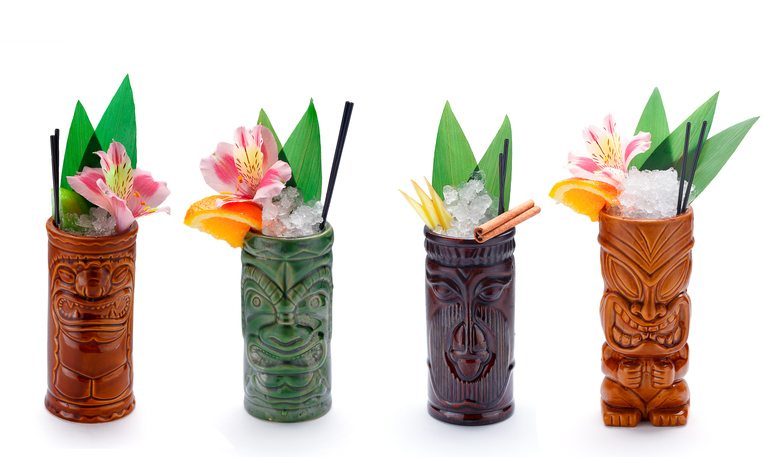Is Digital Advertising Hurting Your Brand?
- An obsession with clicks and form-fills is overshadowing the need to build the brand online
- B2B buyers are increasingly annoyed by and wary of online advertising tactics
- A balanced media plan builds brand and demand
In the 1960s and 1970s Polynesian restaurants were all the rage, and the Kahiki in Columbus, Ohio, epitomized the genre. Garish tropical décor, a simulated rain forest and giant Tiki idols set the stage for equally exotic food that included a number of flaming entrées and drinks. The Columbus Dispatch famously wrote that “the Kahiki is one of the few restaurants in which the food can injure you.” This statement, I assume, referred to the risk of singed eyebrows rather than the hangovers and extra pounds you could gain if you ate there too often. 
Food is supposed to nourish and keep us alive, not hurt us. Without food, we eventually die. Advertising is like food for the brand – intended to increase awareness and bolster positive perception. So, it’s important to ask – is your advertising plan helping to build a healthy brand? Or is it eating away at the trust you’ve built with audiences over time? Are the choices you make in advertising hurting your organization’s long-term success?
Paid media, aka advertising, is and will always be a required part of brand building. I say this as an unabashed advocate of earned media (e.g. PR, AR, social ). Nothing works like the consistent repetition of impressions against a defined audience to create awareness. Without a paid media plan, most brands would have difficulty getting on the map.
When it comes to advertising today, digital represents a large and ever-growing chunk of the budget, but I wonder about its effectiveness as a branding medium. Most digital ad units are tiny and compete for attention in a cluttered environment. According to Integral Ad Science, about half of the display ads that advertisers pay for are not ever actually on the screen. Naturally, in such an environment, advertisers seek ways to increase impressions through techniques that may do as much to hurt as to help your brand:
- Retargeting. The idea behind retargeting is solid – to ensure that viewers who have demonstrated some form of interest in the topic or product see the ad multiple times. Not surprisingly, this increases clickthrough rates and other demand metrics. However, in execution it can become annoying if the ads are popping up for months on end or are appearing in inappropriate environments (the marketing analytics platform in the middle of some awesome Polynesian drink recipes, for example).
- Clickbait. These content gems – “Seven Weird Things You Didn’t Know About X” – are hard to resist, but almost always disappoint in terms of what is delivered. And once you’ve clicked, the seven weird things follow you everywhere you go. Again, this does not really give me the warm and fuzzies about these brands.
- Native advertising. Another growing form of digital advertising is native advertising where commercial messaging is dressed up in editorial clothing to make it appear more credible. There are rules for disclosure, but many people still end up feeling deceived by messages that appear to be one thing but turn out to be another (when the fine print is processed).
In all these examples, people have come to feel that they are being tricked or harassed by advertisers. This weekend I conducted an admittedly unscientific survey of friends and family. I asked, “Do you ever click on the little display ads or ‘sponsored content’ thingies that pop up on the fringes of Web sites?” Everyone answered, without hesitation, no, never. And the reason was that once upon a time they did click on ads, and they have since lived to regret it. My sons, both under 25, said they are not bothered at all by online advertising. They’ve both installed ad blockers, as a majority of Millennials have.
I know what you are thinking – advertisers engage in these techniques because they work – the ad tech vendors and the demand-gen marketers have the stats to prove it. I don’t question that they improve response rates, but response rates do not always equal conversion rates – or revenue. And there is still the question of short-term vs. long-term gain. Brands are about building relationships and trust with our audiences. This is a long game.
Smart sales people especially understand the value of a brand because they experience it every day in how their phone calls are received and their ability to build relationships with prospects. Walking into a room as the representative of an established, trusted brand is a very different experience than representing an unknown entity. However, when push comes to shove, the marketing dollars usually flow in the direction of short-term demand programs rather than long-term brand activities. Ironically, the reason usually given is that this is what we need to do to support sales.
As a member of the Brand and Communications Services team at SiriusDecisions, I frequently talk to clients who are trying to make a case internally for a balanced approach to media that includes a mix of online and offline properties, influencers, sponsorships and solid thought leadership content. Often the first question they’re asked is “Will this drive leads?” And if they can’t guarantee a certain clickthrough rate or lead number in a short period of time, the program doesn’t get funded.
While it can be hard to sell the “nutritional benefits” of long-term brand building against the short-term sugar rush of clicks and form-fills, inevitably, brand health suffers when all we feed our audiences is a diet of demand creation tactics. Stick to a balanced approach and you’ll build a healthy brand that provides value in both the short and long term.